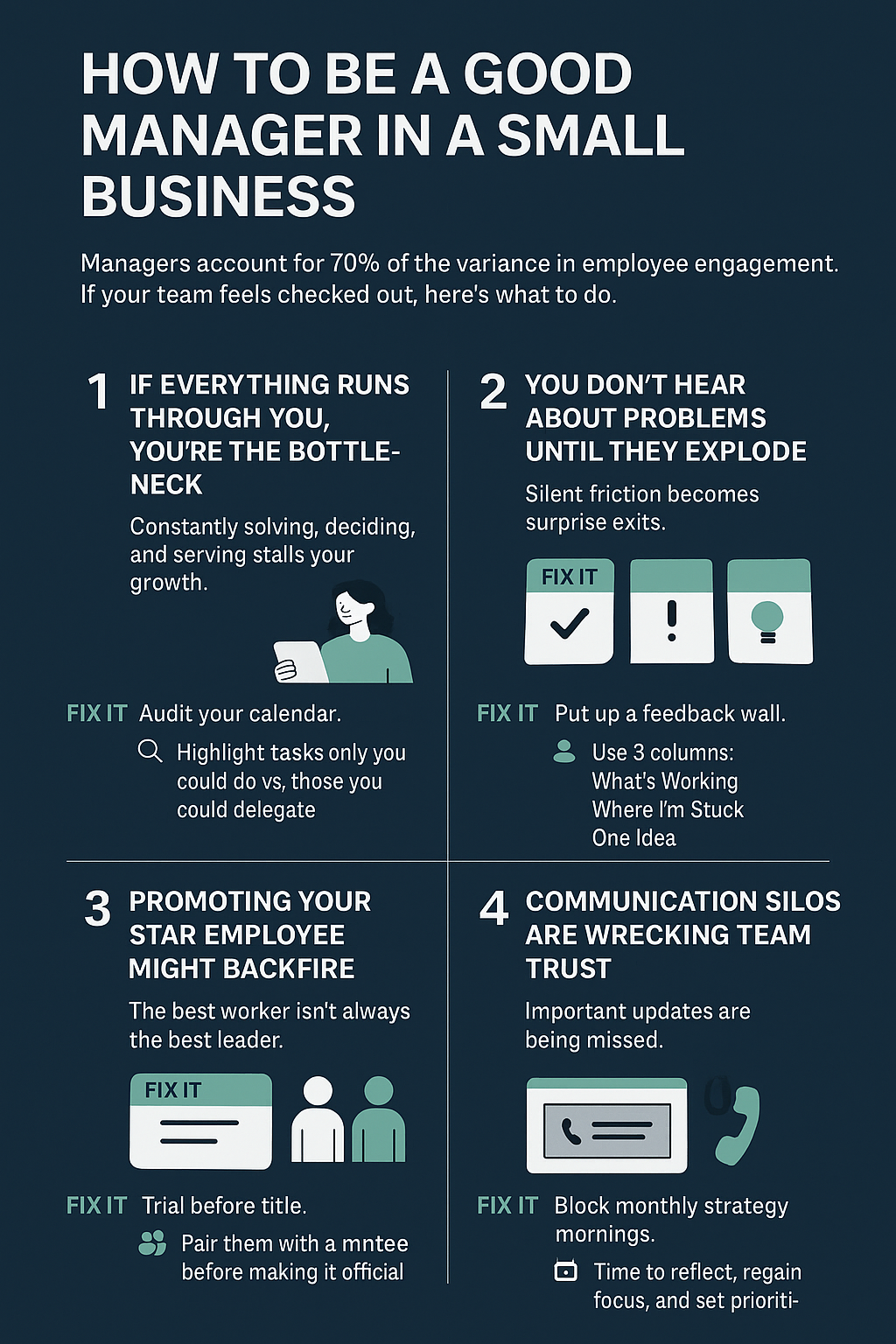Are You a Good Manager in 2025? 5 Hard Truths for Small-Business Owners

Why small business success in 2025 depends on better management, stronger team engagement, and finally fixing the habits that hold your team back.
Running a small business in 2025? Then you're not just a founder - you’re a manager, motivator, problem-solver, and part-time firefighter.
And here's what the data says about that juggling act:
- Global employee engagement is just 21%
- Manager engagement dropped from 30% to 27%
- And most importantly: Managers account for 70% of the variance in employee engagement
(Source: Gallup, 2025)
So if your team seems disconnected, tired, or just going through the motions - it’s probably not because they don’t care. It’s likely because they don’t feel led.
That’s not bad news. It’s a massive opportunity.
Because learning how to be a good manager in a small business isn’t about being perfect—it’s about showing up intentionally, building better systems, and creating a team people actually want to be part of.
Here are 5 painfully common leadership mistakes—and how to fix each one to boost employee engagement, reduce chaos, and lead better.
1. If Everything Runs Through You, You’re the Bottleneck
Why it hurts small businesses:
If you’re the only one who can talk to clients, fix problems, schedule jobs, or make decisions, then your business is stuck at your personal capacity. Your team stays dependent. You stay overwhelmed. Everyone loses.
Example (Service Business Owner):
You own a small HVAC company. You personally approve every quote, assign every job, and troubleshoot every customer issue. When you’re busy or out sick, work grinds to a halt - or worse, mistakes pile up.
Fix: Let go of low-stakes control. Start with this 3-step calendar test.
- Open your calendar.
Highlight every block of time you spent last week on tasks only you can do (e.g., strategy, hiring decisions, client relationships). Now highlight the ones you could have delegated. - Pick 2 low-risk tasks to delegate this week.
Think: ordering supplies, replying to routine client texts, confirming appointments, tracking team hours. - Assign those tasks—clearly.
Don’t just say “you handle it.” Show the system, document expectations, and follow up once.
2. If You Don’t Hear the Little Problems, You’ll Inherit Big Ones
Why it hurts small businesses:
In small, close-knit teams, people tend to avoid conflict. That means issues quietly pile up until someone quits—or worse, a customer walks.
Example (Salon):
One of your stylists is quietly frustrated with how walk-in clients are being assigned, but doesn’t bring it up. Two weeks later, a long-time employee puts in their notice—and you find out too late that it was brewing for months.
Fix: Build a simple, visible feedback loop.
- Set up a physical sticky note wall in a back room or break area with three columns:
- What’s Working
- Where I’m Stuck
- One Idea for Next Week
- Remote or hybrid team? Use a free Miro board with the same layout.
- Make it part of your weekly or monthly rhythm. Review the board during Friday wrap-up or Monday kickoff.
This low-friction system helps surface tension before it becomes turnover—and reminds your team their voice has a place, even if it’s just a Post-it.
3. Promoting Your Star Technician Can Create Your Worst Manager
Why it hurts small businesses:
The best cleaner, stylist, or agent isn’t always the best coach. Without people skills, they’ll frustrate the team they’re supposed to lead.
Example (Cleaning Company):
Your most reliable cleaner becomes a supervisor. She’s great at the job, but condescending to new hires. Two team members quit in a month.
Fix: Run a 30-day mentorship trial before promoting.
- Identify a strong candidate and assign them a mentee.
- Over the next month, have them:
- Shadow together weekly
- Talk through real work challenges
- Practice giving feedback
- At the end, ask the mentee:
- “Did you feel supported?”
- “Would you want them as your manager?”
If the answer is no, they’re not ready. Save the title for someone who can grow others—not just outperform them.
4. If There Are Communication Silos, You Probably Don’t Know What’s Going On
Why it hurts small businesses:
When different team members handle communication separately—texts on personal phones, notebooks, scattered emails—no one sees the full picture. That includes you. And that means things fall through the cracks: double-booked appointments, missed follow-ups, confused clients.
Example (Real Estate Team):
One agent follows up with a lead via text. Another calls them about a different property. You find out only after the client replies, “Why are two people contacting me?”
Embarrassing—and avoidable.
Fix: Centralize communication and make it visible.
- Standardize client communication through one shared system.
- Use Ringo (our business phone solution) to manage calls and texts:
- One shared business number for the whole team
- A single inbox where everyone can view and assign messages
- Visibility into who’s saying what, and when
- During weekly meetings, review one or two recent threads:
- Was the follow-up handled well?
- Did we close the loop?
- Can someone else step in next time with context?
This isn’t about micromanagement—it’s about staying in the loop so you can lead well.
5. If You’re Drained, So Is Your Team
Why it hurts small businesses:
Your team mirrors your mood and pace. If you’re overworked, reactive, or unapproachable, they follow suit—or start checking out.
Example (Startup Founder):
You’re deep in product, handling customer support tickets, rewriting the onboarding flow, jumping into sales demos, and still reviewing every investor update. The team sees you hustling, but they don’t see strategy. They’re guessing at priorities. No one’s thinking long-term—because you’re not modeling it.
Fix: Block a strategy morning every month.
- Take a half-day, phone off, outside the shop or job site.
- Ask yourself:
- What’s the single constraint throttling growth?
- Who could take on more responsibility?
- What will I stop, start, or delegate this month?
You can even involve your team in the discussion to get different ideas and points of view.
Share your final takeaways with your team. That creates accountability—and reminds everyone that someone is driving the ship.

Final Word: You Don’t Need to Be a “Natural Leader.” Just an Intentional One.
You don’t need:
- A VP of People
- More meetings
- Expensive tools
You need:
- Better systems
- Clearer expectations
- A team that knows where they’re going—and feels part of getting there
Managing in 2025 isn’t about perfection. It’s about showing up, staying steady, and giving your people a reason to care.





